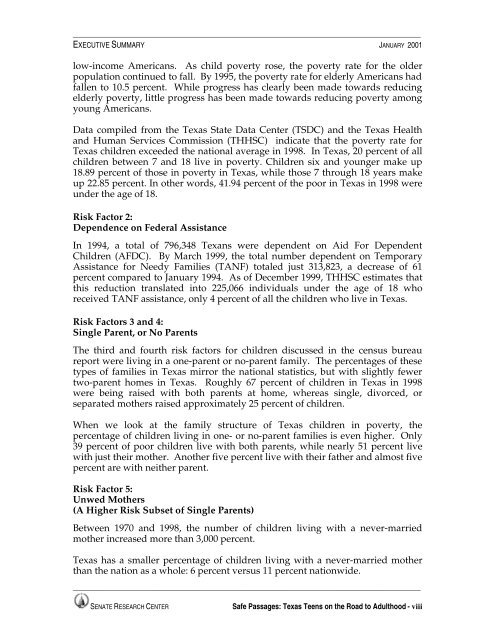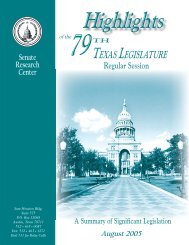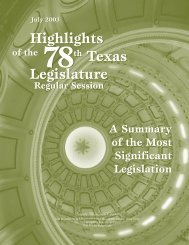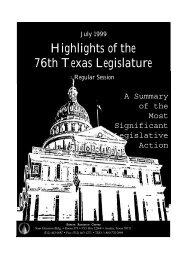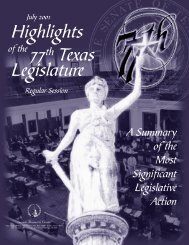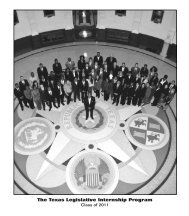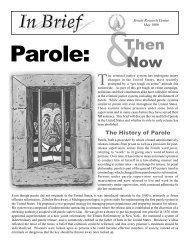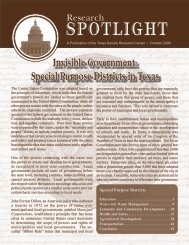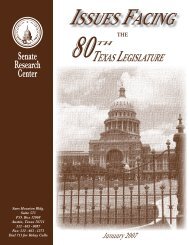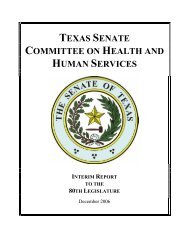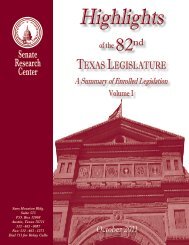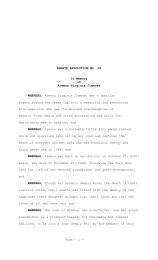Texas Teens Cover - Senate
Texas Teens Cover - Senate
Texas Teens Cover - Senate
Create successful ePaper yourself
Turn your PDF publications into a flip-book with our unique Google optimized e-Paper software.
______________________________________________________________________________________<br />
EXECUTIVE SUMMARY JANUARY 2001<br />
low-income Americans. As child poverty rose, the poverty rate for the older<br />
population continued to fall. By 1995, the poverty rate for elderly Americans had<br />
fallen to 10.5 percent. While progress has clearly been made towards reducing<br />
elderly poverty, little progress has been made towards reducing poverty among<br />
young Americans.<br />
Data compiled from the <strong>Texas</strong> State Data Center (TSDC) and the <strong>Texas</strong> Health<br />
and Human Services Commission (THHSC) indicate that the poverty rate for<br />
<strong>Texas</strong> children exceeded the national average in 1998. In <strong>Texas</strong>, 20 percent of all<br />
children between 7 and 18 live in poverty. Children six and younger make up<br />
18.89 percent of those in poverty in <strong>Texas</strong>, while those 7 through 18 years make<br />
up 22.85 percent. In other words, 41.94 percent of the poor in <strong>Texas</strong> in 1998 were<br />
under the age of 18.<br />
Risk Factor 2:<br />
Dependence on Federal Assistance<br />
In 1994, a total of 796,348 Texans were dependent on Aid For Dependent<br />
Children (AFDC). By March 1999, the total number dependent on Temporary<br />
Assistance for Needy Families (TANF) totaled just 313,823, a decrease of 61<br />
percent compared to January 1994. As of December 1999, THHSC estimates that<br />
this reduction translated into 225,066 individuals under the age of 18 who<br />
received TANF assistance, only 4 percent of all the children who live in <strong>Texas</strong>.<br />
Risk Factors 3 and 4:<br />
Single Parent, or No Parents<br />
The third and fourth risk factors for children discussed in the census bureau<br />
report were living in a one-parent or no-parent family. The percentages of these<br />
types of families in <strong>Texas</strong> mirror the national statistics, but with slightly fewer<br />
two-parent homes in <strong>Texas</strong>. Roughly 67 percent of children in <strong>Texas</strong> in 1998<br />
were being raised with both parents at home, whereas single, divorced, or<br />
separated mothers raised approximately 25 percent of children.<br />
When we look at the family structure of <strong>Texas</strong> children in poverty, the<br />
percentage of children living in one- or no-parent families is even higher. Only<br />
39 percent of poor children live with both parents, while nearly 51 percent live<br />
with just their mother. Another five percent live with their father and almost five<br />
percent are with neither parent.<br />
Risk Factor 5:<br />
Unwed Mothers<br />
(A Higher Risk Subset of Single Parents)<br />
Between 1970 and 1998, the number of children living with a never-married<br />
mother increased more than 3,000 percent.<br />
<strong>Texas</strong> has a smaller percentage of children living with a never-married mother<br />
than the nation as a whole: 6 percent versus 11 percent nationwide.<br />
______________________________________________________________________________________<br />
SENATE RESEARCH CENTER<br />
Safe Passages: <strong>Texas</strong> <strong>Teens</strong> on the Road to Adulthood - viii


